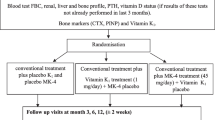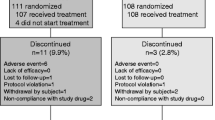Abstract
In a randomized multicenter, double-blind, double-dummy, parallel group study a comparison of the efficacy and safety of 1 μg alfacalcidol to 880 IU vitamin D plus calcium carbonate (1 g calcium) once daily per os was performed on 148 postmenopausal osteoporotic Caucasian patients with normal vitamin D serum levels for 18 months. Bone mineral density (BMD) was measured at baseline, 12 and 18 months. Safety parameters were followed during the entire study period. Sixty-nine (90.8%) in the alfacalcidol group and 67 (93.1%) in the vitamin D group were included in the ITT analysis. Lumbar BMD in the alfacalcidol group increased by 0.017 g/cm2 (2.33%) and 0.021 g/cm2 (2.87%) from baseline (P<0.001) at 12 and 18 months, respectively, whereas in the vitamin D plus calcium group the increase was 0.005 g/cm2 (0.70%) from baseline (N.S.) at both 12 and 18 months. The higher changes from baseline in the alfacalcidol group, as compared to the changes in the vitamin D plus calcium group at both 12 and 18 months, were found to be statistically significant (P=0.018, 0.005). A small increase of mean femoral BMD was achieved in both groups (N.S.). Adverse events were similar in both groups. No significant differences were noted between the groups in serum calcium. In conclusion, alfacalcidol was found to be superior in significantly increasing lumbar BMD as compared to vitamin D plus calcium while safety characteristics were found to be similar in both treatments.


Similar content being viewed by others
References
DeLuca HF (1997) 1,25-dihydroxyvitamin D3 in the pathogenesis and treatment of osteoporosis. Osteoporos Int 7(Suppl 3):S24–S29
Hayashi Y, Fujita T, Inoue T (1992) Decrease of vertebral fracture in osteoporotics by administration of 1α-hydroxyvitamin D3. J Bone Miner Metabol 10(2):184–188
Tilyard MW, Spears GF, Thomson J, Dovey S (1992) Treatment of postmenopausal osteoporosis with calcitriol or calcium. New Engl J Med 326(6):357–362
Menczel J, Foldes J, Steinberg R, Leichter I, Shalita B, Bdolah-Abram T, Kadosh S, Mazor Z, Ladkani D (1994) Alfacalcidol (Alpha D3) and calcium in osteoporosis. Clin Orthop 300:241–247
Orimo H, Shiraki M, Hayashi Y, Hoshino T, Onaya T, Miyazaki S, Kurosawa H, Nakamura T, Ogawa N (1994) Effects of 1α-hydroxyvitamin D3 on lumbar bone mineral density, vertebral fractures in patients with postmenopausal osteoporosis. Calcif Tissue Int 54:370–376
Shiraki M, Kushida K, Yamazaki K, Nagai T, Inoue T, Orimo H (1996) Effects of 2 years treatment of osteoporosis with 1α-hydroxy vitamin D3 on bone mineral density and incidence of fracture: a placebo-controlled, double-blind prospective study. Endocr J 43(2):211–220
Nuti R, Martini G, Valenti R, Giovanni S (1996) Controlled study on the metabolic and absorptiometric effects of calcitriol in involutional osteoporosis. Clin Drug Invest 11(5):270–277
Gallagher JC, Fowler SE, Detter JR, Sherman SS (2001) Combination treatment with estrogen and calcitriol in prevention of age-related bone loss. J Clin Endocrinol Metab 86:3618–3628
Papadimitropoulos E, Wells G, Shea B, Gillespie W, Weaver B, Zytaruk N, Cranney A, Adachi J, Tugwell P, Josse R, Greenwood C, Guyatt G (2002) The osteoporosis methodology group, and the osteoporosis research advisory group. Meta-analysis of the efficacy of vitamin D treatment in preventing osteoporosis in postmenopausal women. Endocr Rev 23:560–569
Lindsay R, Silverman SL, Cooper C, Hanley DA, Barton I, Broy SB, Licata A, Benhamou L, Geusens P, Flowers K, Stracke H, Seeman E (2001) Risk of new vertebral fracture in the year following a fracture. JAMA 285(3):320–323
Gallagher JC, Goldgar D (1990) Treatment of postmenopausal osteoporosis with high doses of synthetic calcitriol. A randomized controlled study. Ann Intern Med 113(9):649–655
Francis RM, Boyle IT, Moniz C, Sutcliffe AM, Davis BS, Beastall GH, Cowan RA, Downes N (1996) A comparison of the effects of alfacalcidol treatment and vitamin D2 supplementation on calcium absorption in elderly women with vertebral fractures. Osteoporos Int 6:284–290
Ringe JD, Dorst A, Faber H, Schacht E, Rahlfs VW (2004) Superiority of alfacalcidol over plain vitamin D in the treatment of glucocorticoid-induced osteoporosis. Rheumatol Int 24:63–70
Scharla SH, Schacht E, Bawey S, Kamilli I, Holle D, Lempert UG (2003) Pleiotropic effects of alfacalcidol in elderly patients with rheumatoid arthritis. Arthritis Rheuma 23(5):268–274
Chapuy MC, Arlot ME, Duboeuf F et al. (1992) Vitamin D3 and calcium to prevent hip fractures in the elderly women. N Engl J Med 327:1637–1642
Chapuy MC, Pamphile R, Paris E et al. (2002) Combined calcium and vitamin D3 supplementation in elderly women: confirmation of reversal of secondary hyperparathyroidism and hip fracture risk: the Decalyos II study. Osteoporos Int 13:257–264
Cooper L, Clifton-Bligh PB, Nery ML et al. (2003) Vitamin D supplementation and bone mineral density in early postmenopausal women. Am J Clin Nutr 77:1324–1329
Orimo H (1994) Clinical application of 1α(OH)D3 in Japan. Akt Rheumatol 19(Suppl 1):27–30
Nishii Y, Sato K, Kobayashi (1993) The development of vitamin D3 analogues for the treatment of Osteoporosis. Osteoporosis Int 3(Suppl 1):S190–S193
Schacht E (1999) Rationale for treatment of involutional osteoporosis in women and for prevention and treatment of corticosteroid-induced osteoporosis with alfacalcidol. Calcif Tissue Int 65:317–327
Grassi F, Leavey JK, Dark K, Qian W, Weitzmann MN, Pacifici R (2004) Bone marrow restricted antigen presentation by dendritic cells induces T cell activation and T CELL TNF production in ovariectomized mice. J Bone Miner Res 19(Suppl 1):S16
Horst RL, Goff JP, Reinhardt TA (1990) Advancing age results in reduction of intestinal and bone 1,25-dihydroxy-vitamin D receptors. Endocrinology 126(2):1053–1057
Rapuri PB, Gallagher JC, Haynatzka V (2004) Interaction between vitamin D receptor and estrogen receptor genotypes does not influence BMD, rate of bone loss and the response to treatment with calcitriol or estrogen in elderly women. J Bone Miner Res 19(Suppl 1):S246
Nordin BEC, Need AG, Morris HA, Horowitz M (1999) The special role of “Hormonal” forms of Vitamin D in the treatment of osteoporosis. Calcif Tissue Int 65:307–310
Lau KHW, Baylink DJ (1999) Vitamin D therapy of osteoporosis: plain vitamin D therapy versus active vitamin D analog (D-hormone) therapy. Calcif Tissue Int 65:295–306
Ringe JD, Schacht E (2004) Prevention and therapy of osteoporosis: the respective roles of plain vitamin D and alfacalcidol. Rheumatol Int 24:189–197
Li XY, Boudjelal M, Xiao JH, Peng ZH, Asuru A, Kang S, Fisher GJ, Voorhees JJ (1999) 1,25-dihydroxyvitamin D3 increases nuclear vitamin D3 receptors by blocking Ubiquitin/Proteasome-mediated degradation in human skin. Mol Endocrinol 13(10):1686–1694
Shibata T, Shira-Ishi A, Sato T, Masaki T, Sasaki A, Masuda Y, Hishiya A, Ishikura N, Higashi S, Uchida Y, Saito M, Ito M, Ogata E, Watanabe K, Ikeda K (2002) Vitamin D hormone inhibits osteoclastogenesis in vivo by decreasing the pool of osteoclast precursors in bone marrow. J Bone Miner Res 17:622–629
van Driel M, Pols HAP, van Leeuwen JPTM (2004) Osteoblast differentiation and control by vitamin D and vitamin D metabolites. Curr Pharm Des 10:2535–2555
DeLuca HF, Cantorna MT (2001) Vitamin D. Its role and uses in immunology. FASEB J 15:2579–2585
Mathieu C, Adorini L (2002) The coming of age of 1,25-dihydroxyvitamin D3 analogs as immunomodulatory agents. Trends Mol Med 8:174–179
Shiraishi A, Takeda S, Masaki T, Higuchi Y, Uchiama Y, Kubodera N, Sato K, Ikeda K, Nakamura T, Matsumoto T, Ogata E (2000) Alfacalcidol inhibits bone resorption and stimulates formation in an ovariectomized rat model of osteoporosis: distinct action from estrogen. J Bone Mineral Res 15:770–779
Shiraishi A, Higashi S, Ohkawa H, Kubodera N, Hirasawa T, Ezawa I, Ikeda K, Ogata E (1999) The advantage of alfacalcidol over vitamin D in the treatment of osteoporosis. Calcif Tissue Int 65:311–316
Ito M, Azuma Y, Takagi H, Komoriya K, Ohta T, Kawaguchi H (2002) Curative effect of combined treatment with alendronate and 1α-hydroxyvitamin D3 on bone loss by ovariectomy in aged rats. Jpn. J. Pharmacol 89:255–266
Duque G, El Abdaimi K, Henderson JE, Lomri A, Kremer R (2004) Vitamin D inhibits Fas ligand-induced apoptosis in human osteoblasts by regulating components of both the mitochondrial and Fas-related pathways. Bone 35:57–64
Reszka AA, Pun S, Rodan GA, Freedman LP, Kimmel DB (2004) Bone anabolic effects of 1,25(OH)2 Vitamin D3 are detected only in the presence of a powerful antiresorptive. J Bone Min Res 19(Suppl 1):S483
Griffin MD, Lutz WH, Phan VA, Bachmann LA, McKean DJ, Kumar R (2001) Dendritic cell modulation by 1α, 25-dihydroxyvitamin D3 and its analogs: a vitamin D receptor-dependent pathway that promotes a persistent state of immaturity in vitro and in vivo. Proc Natl Acad Sci U.S.A. 98(12):6800–6805
Kato T, Chen JT, Katase K, Hirai Y, Hasumi K, Ogata E, Shiraki Y, Shiraki M (1997) Effect of 1α-hydroxyvitamin D3 on loss of bone mineral density immediately after artificial menopause. Endocr J 44(2):299–304
Cranney A, Guyatt G, Griffith L, Wells G, Tugwell P, Rosen C (2002) The osteoporosis methodology group, and the osteoporosis research advisory group. Summary of meta-analyses of therapies for postmenopausal osteoporosis. Endocr Rev 23:570–578
Richy F, Ethgen O, Bruyere O, Reginster J-Y (2004) Efficacy of alphacalcidol and calcitriol in primary and corticosteroid-induced osteoporosis: a meta-analysis of their effects on bone mineral density and fracture rate. Osteoporos Int 15:301–310
Richy F, Schacht E, Bruyère O, Ethgen O, Gourlay M, Reginster JY (2005) Vitamin D analogs versus native vitamin D in preventing bone loss and osteoporosis-related fractures: a comparative meta-analysis. Calcif Tissue Int 76(3):176–186
Bock O, Boerst H, Degner C, Stephan-Oelkers M, Felsenberg D (2004) Underestimated musculoskeletal adverse effects of oral treatment with once weekly alendronate 70 mg and risedronate 35 mg: including possibilities for their prevention. Osteoporos Int 15(Suppl 1):S106
Compston JE (2004) The risks and benefits of HRT. J Musculoskel Neuron Interact 4(2):187–190
Ushiroyama T, Ikeda A, Sakai M, Higashiyama T, Ueki M (2003) Prevention of postmenopausal bone loss with exchange for short-term HRT for 1α-hydroxycholecalciferol. Maturitas 45:119–127
Shiraishi A, Ito M, Hayakawa N, Kubota N, Imai N (2004) Combination therapy with alfacalcidol and risedronate at their subtherapeutic doses can additively improve bone dynamics in ovariectomized rat model of osteoporosis. J Bone Miner Res 19(Suppl 1):S180
Author information
Authors and Affiliations
Corresponding author
Rights and permissions
About this article
Cite this article
Nuti, R., Bianchi, G., Brandi, M. et al. Superiority of alfacalcidol compared to vitamin D plus calcium in lumbar bone mineral density in postmenopausal osteoporosis. Rheumatol Int 26, 445–453 (2006). https://doi.org/10.1007/s00296-005-0073-4
Received:
Accepted:
Published:
Issue Date:
DOI: https://doi.org/10.1007/s00296-005-0073-4




